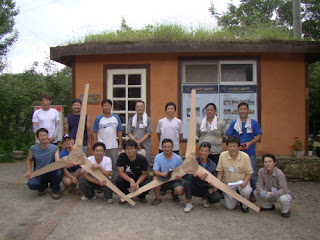Solar energy has the most potential among all the renewable energy resources. Every day in Korea
Participants in the Solar Energy Workshop will learn the principles behind harnessing solar energy. They will learn about how to connect photo-voltaic cells with controllers and inverters, getting hands-on experience with the technology. The workshop teaches participants to measure how much electricity they need and how thick of a cord they need to transmit that electricity. Participants will also learn about three different ways to harness solar energy. First, they will learn how to capture light energy using photo-voltaic cells. Second, they will learn use heat energy to cook food, constructing a simple solar oven using only styrofoam, cardboard, aluminum foil, and glass. Third, they will learn how to use solar power to heat a passive solar house.
The Scheffler Reflector was invented by Wolfgang Scheffler in 1986. Scheffler intentionally designed the reflector using materials and construction techniques that were common to rural areas in Kenya and India
Participants in the Scheffler Reflector Workshop will construct their own reflectors with the help of their fellow team members. The reflector’s intermediate, appropriate technology design coupled with its incredible effectiveness makes it ideal for use in many different environments. It is a perfect example of the kind of technology that the AT Center exists to promote.
Box Oven Solar Cooker Workshop
Whereas the Solar Energy Workshop teaches participants the principles behind harnessing solar energy, this workshop teaches participants to construct a permanent solar cooker. The solar cooker that participants construct in the Solar Energy Workshop is only temporary since it is made of things like styrofoam and cardboard. This solar cooker is made of wood and is designed to withstand the elements. This workshop is ideal for participants who are serious about trying to cook their food using solar power.
Wind Turbine Workshop
The Wind Turbine Workshop teaches participants to construct an Avial Flux Wind Turbine, after the design of inventor Hugh Piggott. Participants in this workshop learn about woodwork, welding, and electricity. The blades of the turbine are made of wood and the generator is made using copper wire and magnetism. The amount of electricity that this turbine can produce varies depending on where it is used. In the Sancheong area of Kyungnam, our turbines can produce about 500 watts of power. On the Scottish seacoast where Hugh Piggott first designed and built this style of turbine, it can produce 1 kilowatt. This workshop is ideal for DIY people who love to learn new ways to apply their skills in the areas of carpentry, welding, and electric work.
Human Powered Generator Workshop
The Human Powered Generator Workshop teaches participants how to convert human energy into electricity. In this workshop, we remove the back wheel of a bicycle and replace it with it a generator. When a person pedals the bicycle, the energy they produce is stored in a battery. This energy can be used to power lights and basic home appliances. Participants in this workshop will learn about how electricity works. They will learn to use generators, batteries, and inverters, as well as how to weld the generator to the bicycle. This workshop is ideal for those who want to combine their love of exercise with their interest in alternative technology.
Bill Mollison, an Australian ecologist, coined the term “Permaculture” in 1978 with the help of his student, David Holmgren. Permaculture is the idea that human living spaces can be designed in such a way that they reside in harmony with the plants, animals, and earth around them. Mollison defines Permaculture by saying that it “…is a design system for creating sustainable human environments.” The word comes from the combination of the words PERMAnent and agriCULTURE. Advocates of this discipline teach that human beings have no right to devastate the environments around them. They argue that humans must learn to be good stewards of the Earth.
In the Permaculture Design Workshop, instructors from Crystal Waters, Austrailia will join with Korean Permaculture experts to share about this revolutionary idea. The AT Center promotes Permaculture because we believe that living sustainably requires more than just adopting alternative technology. We must learn to change our lifestyles if we want to practice sustainable living. This workshop is ideal for participants who want to learn to live in harmony with the environment around them.
The Bio-Mass Workshop covers two major topics. Participants will learn to make bio-diesel fuel and they will also learn to produce energy using methane gas. The workshop teaches about how excess vegetable oil can be used to make bio-diesel fuel through a specific chemical reaction. This bio-diesel fuel can then be used in any diesel automobile engine, and it is also far less expensive than traditional diesel fuel. Most of all, bio-diesel fuel burns clean. When fossil fuels are burned, they emit high amounts harmful carbon dioxide gas that contributes to climate change. When bio-diesel fuel is burned, it emits much less carbon dioxide. Thus bio-diesel is a cheaper, more environmentally friendly option for fueling diesel automobiles.
Participants will also learn about how to produce methane gas through anaerobic composting. The workshop teaches about how to compost using things like human manure, animal manure, food scraps, grass clippings, and several other substances. Any material that has both carbon and nitrogen can be composted to produce methane. Moreover, a 1 cubic meter methane gas tank can supply the gas needed to cook three meals a day for a family of 5. It can also produce 1.25 kilowatts of electricity, which is enough to light a 100 watt balb for 6 hours. This workshop is perfect for participants who want to learn about how to turn materials that are often thrown away into energy for daily life.




